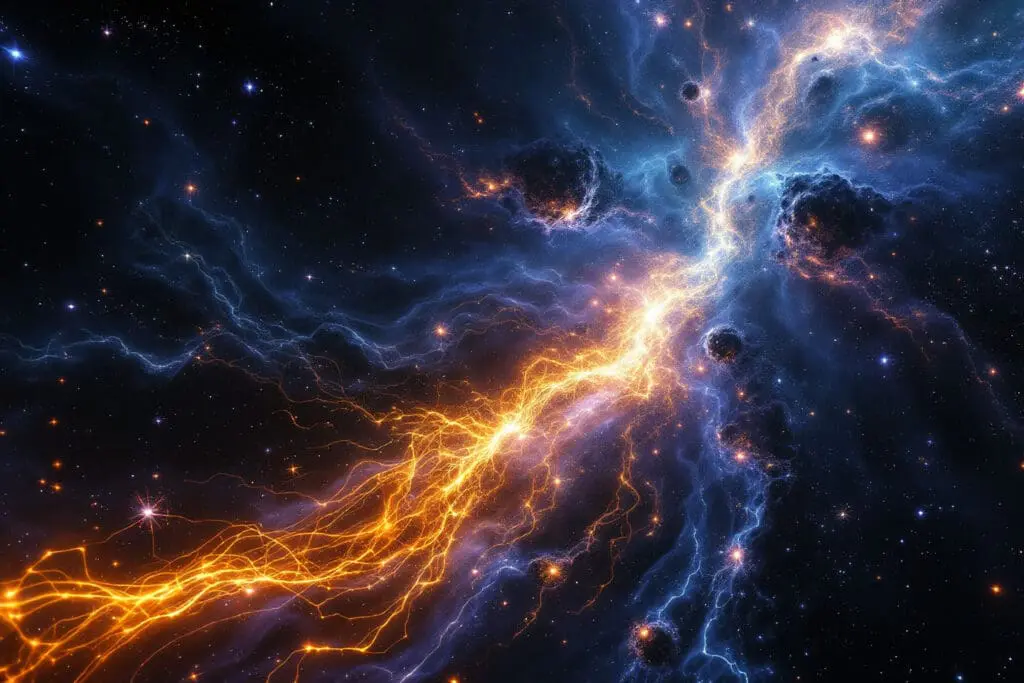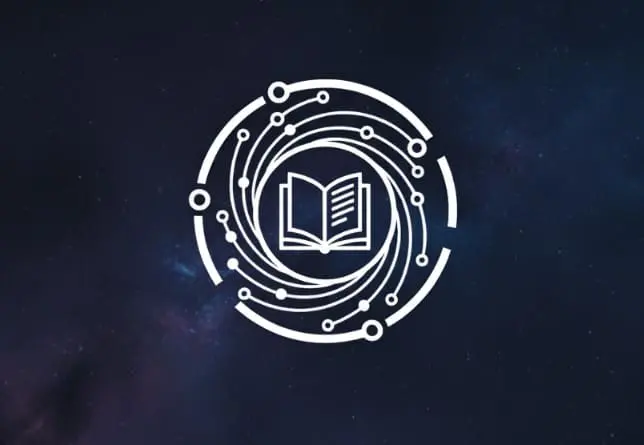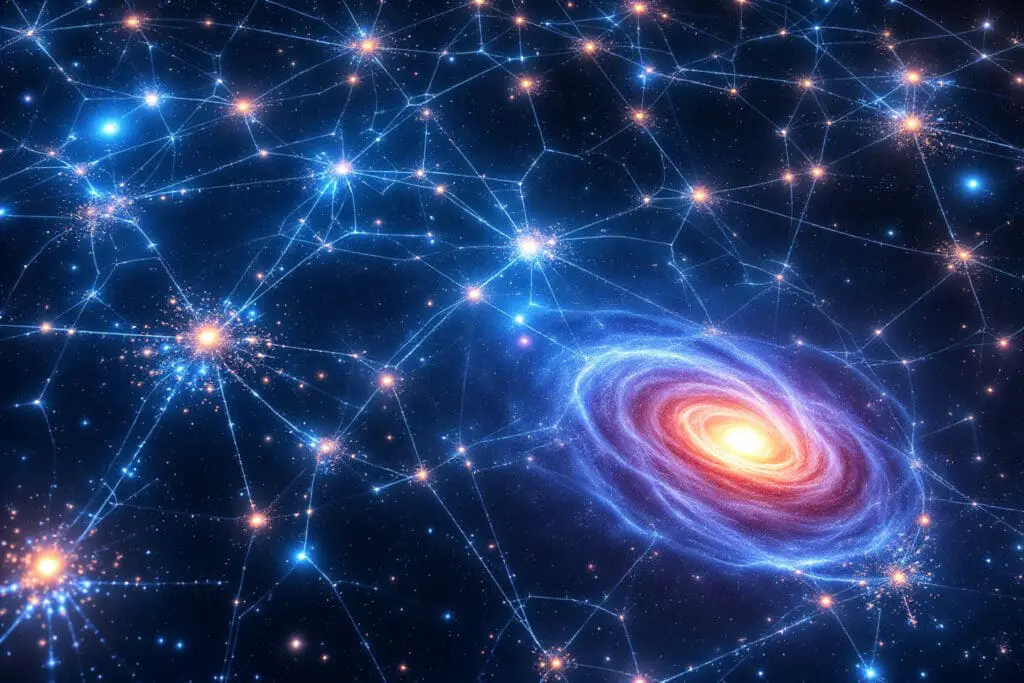Look up tonight. See that endless, star-dusted darkness? It sparks a feeling, doesn’t it? A deep, profound wonder. It makes you ask the big questions. The really big ones. Where did all this come from? How did the stars, the planets, and even you get here?
These aren’t just late-night thoughts. They are real questions with scientific answers. The science is called cosmology, and it’s the ultimate detective story. Its mission? To understand the origin and evolution of the entire universe. We’re the detectives, using light from billions of years ago as our main clue. This is the story of how cosmology explains our origin, a journey from the very first spark of existence to us, right here, on this small blue dot. This is a story told by physics. A story seen through telescopes. It is our story.
More in The Big Picture Category
How Astrophysics Explains Stars
Key Takeaways
- The universe as we know it kicked off about 13.8 billion years ago with the Big Bang, starting as a point of incredible heat and density before expanding.
- In the beginning, there was only hydrogen and helium. Every heavier element—the carbon in your cells, the oxygen you breathe—was forged in the heart of a star.
- Massive stars went out with a bang. These supernova explosions seeded the cosmos with the heavy elements needed to build new stars, planets, and eventually, us.
- About 4.6 billion years ago, a cloud of this cosmic dust and gas collapsed, forming our solar system and our home, Earth.
- The grand structure of the universe, the web of galaxies including our own Milky Way, was shaped by the invisible gravitational pull of dark matter.
So, Where Did It All Begin?
To get to our beginning, we have to go back. Way back. Not just a few centuries, but 13.8 billion years. We need to go back to the first tick of the cosmic clock. This is where we find the Big Bang theory, the powerful, evidence-backed story of how everything came to be. It wasn’t really a bang, though. It was the start of expansion itself.
What Exactly Was the Big Bang?
First, let’s clear something up. The Big Bang wasn’t a bomb going off in the middle of an empty room. That’s a huge misconception. The real picture is far stranger. Try to imagine all of space, all of time, all of everything, squeezed into a single point hotter and denser than anything we can comprehend. A singularity. The Big Bang, then, wasn’t an explosion in space. It was the sudden, rapid expansion of space.
In the tiniest fraction of that first second, the universe inflated at a mind-boggling rate, growing faster than light itself. As space stretched, it cooled. The basic building blocks of our reality—quarks, electrons, photons—started to condense from a scorching soup of energy. Just a few minutes in, things had cooled enough for protons and neutrons to get together, forming the nuclei of the very first elements: hydrogen and helium. And for a few hundred thousand years, that was the entire menu.
Can We See Evidence of This Beginning?
You’d think an event that ancient would be lost to time. But it’s not. We can actually see the leftover glow from that primordial fire. It’s called the Cosmic Microwave Background, or CMB. It is, quite literally, the universe’s baby picture. Around 380,000 years after the start, the cosmos cooled just enough for atoms to form. That was a game-changer. For the first time, light could travel through space without being instantly scattered.
That very same light is still traveling across the cosmos today. Billions of years of cosmic expansion have stretched it into the microwave part of the spectrum. In 1965, two astronomers stumbled upon it—a faint, persistent hum coming from every single direction in the sky. They had found the Big Bang’s afterglow. On top of that, we see that all distant galaxies are flying away from us. The farther they are, the faster they go. This cosmic expansion, first clocked by Edwin Hubble, is exactly what you’d expect to see if everything started from a single point.
If Everything Started as Hydrogen and Helium, Where Did We Come From?
This is the big question, isn’t it? Take a look around. You, the chair you’re on, the planet you’re on—it’s all made of stuff like carbon, oxygen, and iron. If the Big Bang only made the lightweights, where did the rest of the periodic table come from? Where did the ingredients for life originate? The answer was forged in fire. In the hearts of stars. Stars are the chemical factories of the universe.
How Were the First Stars Born?
In the beginning, after the initial glow faded, the universe was dark. Pitch black. It was filled with enormous, unseen clouds of hydrogen and helium. But gravity is patient, and it is relentless. The universe wasn’t perfectly smooth; some spots were a tiny bit denser than others. Gravity latched onto those spots.
Over millions of years, it patiently pulled the gas in those denser regions into ever-tighter clumps. As these clouds collapsed, the centers got crushed under the weight. The pressure and temperature shot through the roof until, finally, a tipping point was reached. It became so hot, so dense, that hydrogen atoms started smashing together and fusing into helium. That process, nuclear fusion, unleashes a colossal amount of energy.
A star flickered on. The cosmic dark ages had ended.
Aren’t We Made of More Than Just Gas?
You bet we are. And this is where the alchemy begins. A star’s life is a constant battle against gravity, and fusion is its weapon. But it doesn’t just stop at turning hydrogen into helium.
The stellar furnace keeps on cooking:
- Helium atoms fuse to become carbon.
- Carbon fuses into oxygen.
- Oxygen fuses into silicon.
- The chain reaction continues, building heavier and heavier elements, all the way up to iron.
Think about that. The carbon in your genes, the oxygen filling your lungs, the iron in your blood—every single heavy atom in your body was manufactured deep inside a star that lived and died long before our Sun was even a twinkle in the cosmos. Carl Sagan was right on the money when he said, “We are made of star-stuff.” It wasn’t poetry. It was a fact.
How Did Star-Stuff Become Planets and People?
Okay, so stars are element factories. But having all those valuable elements locked away inside a star doesn’t do anyone much good. How did they get out? How did they end up as planets, trees, and us? The life of a star makes the ingredients. The spectacular death of a massive star is what delivers them.
What Happens When a Massive Star Dies?
A star like our Sun will go out with more of a whimper than a bang. But for the real giants, the heavyweights of the cosmos, the end is the most violent and brilliant event in the universe: a supernova. Once a massive star has burned through its fuel, its core collapses in an instant under its own crushing gravity. This triggers a rebound shockwave of unimaginable power, blowing the star to pieces.
That explosion is so intense it forges all the elements heavier than iron—gold, uranium, platinum—in a flash. But more importantly, the supernova acts like a cosmic delivery truck, blasting all the elements the star so carefully crafted over its lifetime out into the galaxy. It enriches the surrounding space, providing the essential building blocks for whatever comes next.
So, Our Solar System is Recycled Stardust?
You got it. Our Sun isn’t a first-generation star. It’s a descendant, built from the ashes of its ancestors. Roughly 4.6 billion years ago, a nearby supernova probably sent a shockwave ripping through a cold, quiet cloud of gas and dust. This cloud, already chock-full of heavy elements from countless prior supernovas, started to collapse under its own gravity.
The lion’s share of the material spiraled into the center, got hotter and hotter, and eventually ignited into our Sun. The leftovers formed a spinning platter around the newborn star—a protoplanetary disk. In that disk, tiny specks of dust and ice began to bump into each other and stick. These clumps grew into pebbles, then boulders, then planet-sized bodies. After millions of years of chaotic collisions, the planets, including our own rocky Earth, had taken shape.
What Role Do Galaxies Play in This Grand Story?
Stars and planets aren’t just sprinkled randomly throughout the void. Gravity gathers them into breathtakingly vast cities of stars we call galaxies. Our home city is the Milky Way, a spiral galaxy containing hundreds of billions of stars. The story of our galaxy is inseparable from the story of our origin.
Why Aren’t Stars Just Scattered Everywhere?
Gravity pulls on everything. Just as it clumps gas into stars, it herds stars into galaxies. The first little galaxies, mere toddlers, began to form just a few hundred million years after the Big Bang. Over the eons, they’ve crashed and merged, growing into the giant galaxies we see today. The Milky Way is a dynamic, swirling metropolis of stars, gas, and dust, all orbiting a supermassive black hole. This grand structure provides the framework for the endless cycle of star birth, death, and rebirth.
Does Our Position in the Milky Way Matter?
It’s a matter of life and death. Scientists talk about a “galactic habitable zone,” a kind of cosmic sweet spot where life has the best shot. If we were too close to the chaotic galactic center, we’d be fried by radiation and torn apart by intense gravity. It’s a rough neighborhood.
But if we were too far out in the galactic boondocks, there wouldn’t be enough heavy elements to go around. You can’t build a rocky planet like Earth without the raw materials. Our solar system is in a pretty quiet suburban street—the Orion Arm—a perfect distance from the downtown chaos. This location has given Earth billions of years of peace and quiet, which was absolutely essential for the slow, meandering path of evolution to unfold.
Is the Universe Just Matter? What About the Invisible Stuff?
For years, a huge puzzle has been staring astronomers in the face. When they looked at how galaxies spin, the numbers didn’t add up. The gravity from all the stars, gas, and dust they could see wasn’t nearly enough to hold them together. They were spinning so fast they should have torn themselves to shreds. Something else had to be there. Something invisible.
What is This “Dark Matter” I Keep Hearing About?
Dark matter is perhaps the single biggest mystery in cosmology today. It’s some kind of substance that’s completely invisible; it doesn’t emit, block, or reflect any light. The only reason we know it’s there is because we can see its gravity pulling on the things we can see. It’s the invisible cosmic web that holds the universe together.
Our best guess is that dark matter outweighs all the normal matter—all the stars, planets, and galaxies—by more than five to one. Without it, the tiny seeds of structure in the early universe would never have had enough gravitational oomph to grow into the galaxies we see today. In a very real way, our Milky Way exists because it’s built on a foundation of this mysterious, unseen stuff.
And What’s Driving the Universe to Expand Faster?
Just when you thought it couldn’t get weirder, it did. In the late 1990s, astronomers studying distant supernovas found something that made no sense. The expansion of the universe wasn’t slowing down under gravity’s pull as everyone expected. It was speeding up.
The only way to explain this is to propose some kind of invisible energy woven into the fabric of space itself—what we now call “dark energy.” It acts as a kind of anti-gravity, pushing everything apart. And it’s the boss. Dark energy makes up almost 70% of the entire universe, and it’s pushing the cosmos toward its ultimate fate. To learn more, check out NASA’s in-depth explanation of Dark Energy.
Does This Mean Our Existence Was Inevitable?
This whole story, from a single point to a species that can ponder its own existence, is almost too much to take in. It makes you wonder. Was this all a cosmic accident? Or is the universe somehow built for life?
Are the Laws of Physics Fine-Tuned for Life?
This is where things get really spooky. When scientists look at the fundamental numbers that govern our universe—the strength of gravity, the charge of an electron—they notice something odd. These numbers seem to be balanced on a knife’s edge.
If you tweaked the strength of gravity by even a tiny, tiny amount, the universe would have either re-collapsed immediately or expanded so fast that stars never formed. Change the value of the nuclear strong force, and stars couldn’t make carbon, the very basis of life. This “fine-tuning problem” has led some scientists to wonder if our universe is just one of countless others in a multiverse, each with different laws—and we just happen to live in the one where the numbers came up right.
What Is Our Cosmic Address?
The scale of it all is hard to grasp. Our story has unfolded in a very specific place. If you had to write down your full cosmic address, it would be something like this: You, Earth, the Solar System, the Orion Arm, the Milky Way Galaxy, the Local Group, the Virgo Supercluster, the Laniakea Supercluster. We are a tiny part of a structure so vast it’s almost meaningless to us, in one galaxy out of potentially trillions. This perspective doesn’t make us small. It makes the fact that we’re here at all a miracle.
So, What Does It All Mean for Us?
We’ve bridged a gap of 13.8 billion years. We followed the thread from a universe of simple gas to a cosmos brimming with the chemical ingredients for planets, and on at least one of those planets, for life.
How Does Knowing Our Cosmic Origin Change Our Perspective?
To truly grasp how cosmology explains our origin is to see the world differently. It’s a creation story for the 21st century, one grounded in evidence. It tells you that you are not just living in the universe; you are the universe, experiencing itself. Every atom in your body has a history that is billions of years old. This isn’t just a cool fact. It’s a profound connection to everything. It’s a reason for awe, a reason for humility, and a reason to feel at home in the cosmos.
What Are the Next Frontiers in Cosmology?
We are nowhere near done. The story is still being written. The James Webb Space Telescope is staring into the cosmic dawn, capturing images of the very first galaxies switching on. Deep underground, physicists are hunting for a single particle of dark matter. All over the world, astronomers are mapping the sky to get a better handle on the dark energy that is shaping our future. Every day, we learn a little more. The journey continues.
FAQ – How Cosmology Explains Our Origin

What is our cosmic address and why is it important?
Our cosmic address includes Earth, the Solar System, the Milky Way Galaxy, various larger structures, and superclusters, illustrating our tiny place in the vast universe and fostering humility and a sense of connection to the cosmos.
What causes the universe to expand at an accelerating rate?
The acceleration of the universe’s expansion is driven by dark energy, a mysterious form of energy that acts as a kind of anti-gravity, working against gravity and causing the universe to expand faster over time.
How did heavier elements like carbon and oxygen form in the universe?
Heavier elements were formed inside stars through nuclear fusion processes, where lighter elements like hydrogen and helium fuse into heavier ones such as carbon, oxygen, and silicon during the stars’ lifetimes and explosive deaths.
What is the significance of the Cosmic Microwave Background in understanding the universe’s origins?
The Cosmic Microwave Background is the residual radiation from the early universe, serving as a baby picture of the universe that provides critical evidence for the Big Bang theory and insights into the universe’s infancy.

